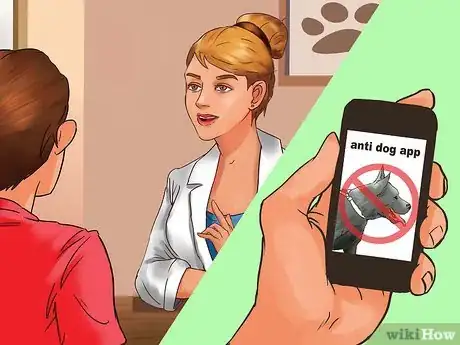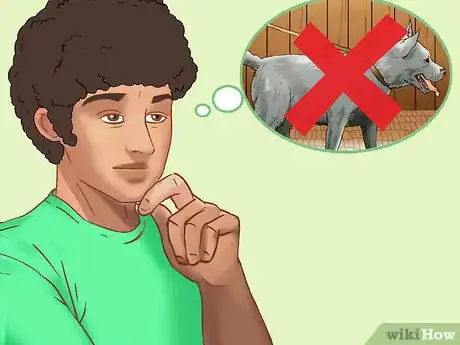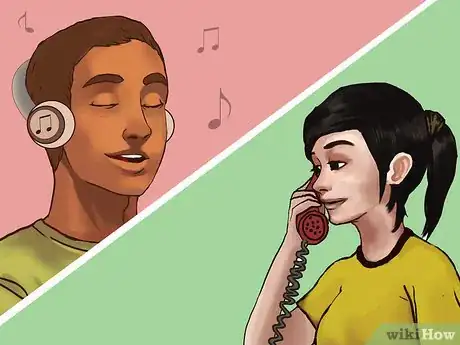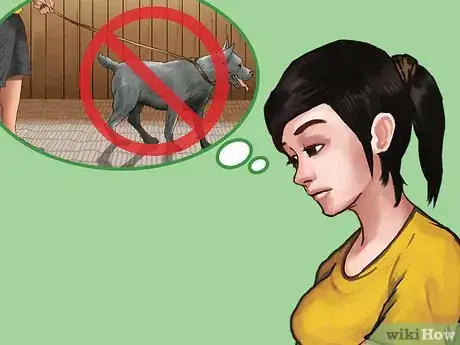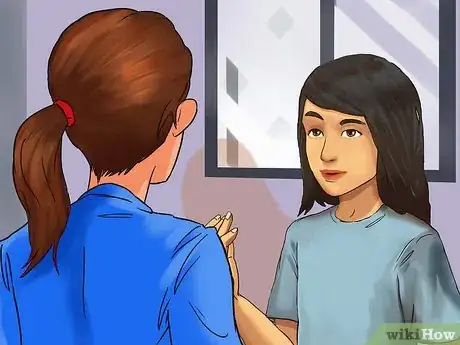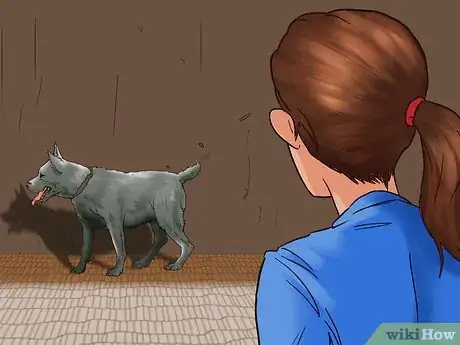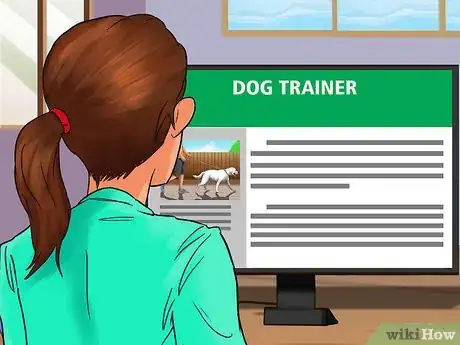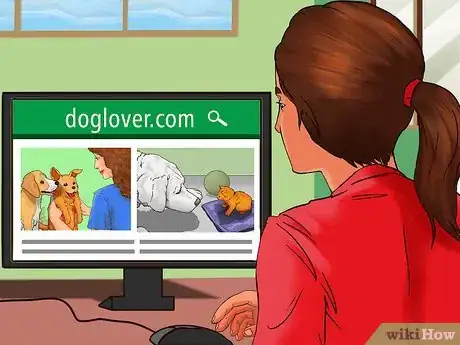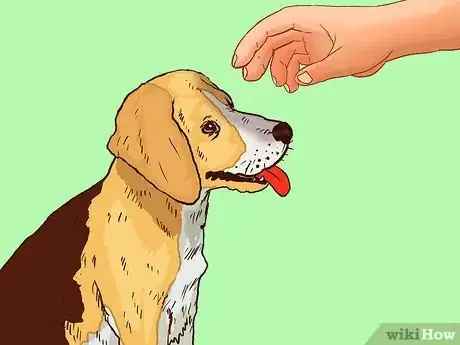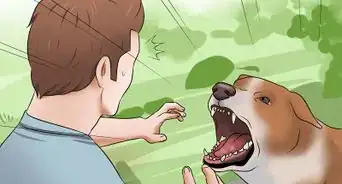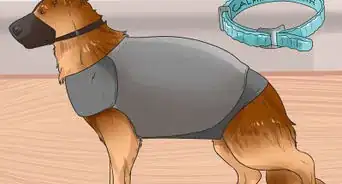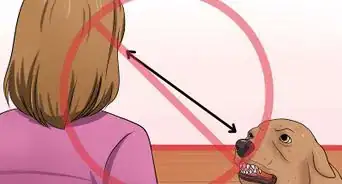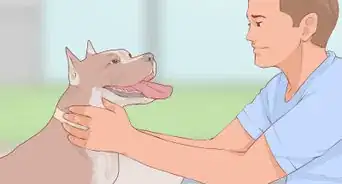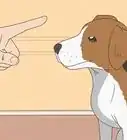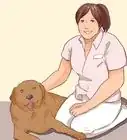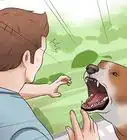This article was co-authored by Natalia S. David, PsyD. Dr. David is an Assistant Professor in Psychology at the University of Texas Southwestern Medical Center and a Psychiatry Consultant at Clements University Hospital and at Zale Lipshy University Hospital. She is a member of the Board of Behavioral Sleep Medicine, the Academy for Integrative Pain Management, and the American Psychological Association’s Division of Health Psychology. In 2017, she received the Baylor Scott & White Research Institute’s Podium Presentation Award and scholarship. She received her PsyD from Alliant International University in 2017 with an emphasis in Health Psychology.
There are 10 references cited in this article, which can be found at the bottom of the page.
This article has been viewed 30,311 times.
Getting bit by a dog can lead to a variety of symptoms of post-traumatic distress and anxiety;[1] however, there are plenty of steps you can take to deal with emotional trauma following a dog bite. Cope with anxious feelings with breathing exercises, activities that will refocus your mind, and by spending time with loved ones. Talk to a counselor if you could use some professional guidance. Limit your exposure to dogs soon after your experience, but empower yourself by learning about dog behavior. Try to gradually overcome your trauma by interacting with a trusted friend or family member’s dog.
Steps
Coping with Acute Anxiety
-
1Address your safety and wellbeing. Anxiety after a dog bite may be connected to the trauma of the event, but it may also relate to reasonable safety concerns. Address any anxiety relating to your heath immediately after the bite — ask your doctor if you need a tetanus shot or any other treatment to ensure you stay healthy. Then take steps to make sure you feel secure and safe. For instance, you may feel safer if you have the number to Animal Control programmed into your phone, or if you have a First Aid kit in your backpack or purse.
- When you visit friends or family with dogs, you can ask them to make sure the dogs are securely in another room or somewhere that you don't have to worry about them escaping and compromising your safety.
-
2Limit your exposure to dogs soon after getting bit. It’s completely reasonable to be afraid of dogs and to avoid them after a traumatic experience, especially right after it occurs. It’s okay if you don’t want to walk down the street where it happened, don’t want to visit your family member who has a big dog, or otherwise take steps to limit your exposure to dogs. Give yourself time to regain a sense of equilibrium or balance before trying to face your fear.[2]Advertisement
-
3Practice tightening and relaxing exercises. Take deep breaths and relax your body. Clench your fist and visualize all your feelings of anxiety concentrating in your fist, leaving the rest of your body. Hold your fist for five seconds, then release it, and as you do so, imagine your anxious thoughts melting away.[3]
- You can also try pulling your shoulders up into a shrug, focusing your anxious thoughts there, holding them for five seconds, then releasing them along with your anxiety.
- You try these exercises any time you feel anxious or are near a dog.
-
4Break the cycle of anxiety. When you start to feel yourself getting anxious or thinking scary thoughts, stop what you’re doing. Go on a walk, call a friend, listen to music, or do a hobby that helps keep your mind occupied.[4]
- Refocus your thoughts, and if your mind starts to race, say to yourself, “Stop. Don’t go into that vicious cycle. I have power over my thoughts and I have the power to put myself in a better headspace.”
-
5Avoid “what if” thinking and blaming yourself. Try not to think of what you should or could have done in order to prevent getting bit. Don’t think of the situation as your fault. Instead, and only when you’re ready, try to learn about dog body language and tips for preventing bites in the future.[5]
- Say to yourself, “The dog’s owner really should have had him leashed and supervised. It was a frightening moment, but I can use this opportunity to empower myself. I will gradually regain my confidence.”
-
6Talk to a loved one. Have regular chats with a good friend, family member, a faith leader, or another member of your community whom you trust. Simply spending time with people you care about offers a sense of comfort and will help you regain confidence.[6]
- You don’t need to talk about your traumatic experience every time you talk to someone. Just staying connected with your support circle helps. You should talk about the experience at some point, but you don’t need to focus only on your trauma in conversations with your loved ones.
-
7Consider talking to a counselor. Think about seeing a counselor if you have trouble concentrating at work or school, avoid social situations that you used to enjoy, are unable to go outside, or are unable to discuss your trauma at all. A counselor will help you break patterns of anxious thinking, find new ways of understanding your trauma, and help empower you to overcome your fears.[7]
- Mental health professionals can also help you consider whether a prescription medication, either in the short- or long-term, would be beneficial.[8]
Empowering Yourself
-
1Educate yourself about dog behavior. Learn how to interpret dog body language in order to empower yourself in the future. Remember not to focus on what you should have done in the past, but on how you can regain your confidence.[9]
- Get to know, for instance, how a dog holds its ears down and back to show that it’s uncomfortable, or how a side eyed glance communicates that it doesn’t like an interaction.
- You can start by checking out the resources on dog behavior and communication available on the American Society for the Prevention of Cruelty to Animals (ASPCA) website: http://www.aspcapro.org/webinar/2012-04-19-040000/canine-body-language
-
2Learn what to do if you’re confronted by a dog. While it’s okay to avoid dogs soon after getting bit, you might eventually want to walk your normal route or visit your family member who has a big dog. Knowing how to handle a confrontation with a dog can give you a sense of security in addition to help you prevent another bite.
- When you see an unleashed, unfamiliar dog, don’t approach it. Don’t run away, panic, or make loud noises.
- Stay still and try to be calm. Stay aware of the situation, but take deep breaths and do your best to stay in control of any scared or anxious feelings. Keeping your heart rate and breathing in control will help the dog understand you’re not a threat.
- Avoid direct eye contact and try not to face your body directly at it. Instead, try standing with the side of your body facing the dog so you don’t appear aggressive. Say “No!” or “Go home!” in a firm, deep voice. Wait for the dog to pass or slowly back away.
-
3Consider finding a trainer if your family’s dog bit you. If possible, ask your parents or other household member to take on your care duties while you work to regain your confidence. Find a trainer and enroll in classes so your family dog can learn obedience and so you can master defensive handling techniques.[10]
- Ask your dog’s vet or dog-owning friends and family for a referral to a good trainer. Look for a trainer accredited by the Certification Council for Professional Dog Trainers (CCPDT). You can use the council website’s search tool for help finding a local trainer: http://www.ccpdt.org/dog-owners/certified-dog-trainer-directory/
Facing Your Fear of Dogs
-
1Look at pictures and videos of people interacting with dogs. Start small and face your fears gradually. Look online for images and videos of people and dogs playing. Look for cute pictures of puppies, people cuddling with their dogs, and other positive imagery.[11]
- Try looking for books at your local library. For example, the American Kennel Club’s The Complete Dog Book is a good start.[12]
- Say to yourself, “I had one negative experience, but I can have positive experiences with dogs in the future. It is possible and probable that I will interact with dogs free of fear and worry.”
-
2Have a friend or family member bring their dog around you. Think of a trusted friend or family member who owns a dog. Try to find someone who owns a smaller, less intimidating breed (unless you find smaller dogs provoke more anxiety). Have them keep their dog leashed in the same room as you.[13]
- When overcoming a fear or phobia, it’s important that you retain a sense of control. Do the exercise wherever you feel most comfortable, whether it’s at your loved one’s home, your home, or a neutral location.
- Keep the interaction to a minimum at first. Just spend a half hour or so in the same room as a dog once a week.
-
3Increase your confidence level until you’re able to touch the dog. Over time, decrease the distance you keep between you and your loved one’s dog. Try to move a few feet closer each time you meet them.[14]
- Eventually, try to get to the point where you can hold your hand close to the dog and allow it to sniff you. Let it smell your hand and get to know you, then gently pet the dog. If your friend has a treat handy, try offering it a treat or giving it a command, like “Sit.”
References
- ↑ https://www.ncbi.nlm.nih.gov/pmc/articles/PMC2783041/
- ↑ http://doggonesafe.com/how_to_help_your_child_after_a_dog_bite/
- ↑ http://www.nbcnews.com/id/15223582/ns/health-pet_health/t/take-bite-out-your-fear-dogs/#.WI-3_xsrLb0
- ↑ https://www.mayoclinic.org/diseases-conditions/post-traumatic-stress-disorder/diagnosis-treatment/drc-20355973
- ↑ http://doggonesafe.com/how_to_help_your_child_after_a_dog_bite/
- ↑ https://www.mayoclinic.org/diseases-conditions/post-traumatic-stress-disorder/diagnosis-treatment/drc-20355973
- ↑ http://www.apa.org/pi/families/resources/children-trauma-update.aspx
- ↑ https://www.mayoclinic.org/diseases-conditions/post-traumatic-stress-disorder/diagnosis-treatment/drc-20355973
- ↑ https://www.psychologytoday.com/blog/decoding-your-pet/201412/dogs-dont-bite-out-the-blue
- ↑ http://www.mnn.com/family/pets/questions/how-do-i-find-a-reputable-dog-trainer-who-doesnt-cost-a-fortune
- ↑ http://www.cnn.com/2012/10/08/living/mnn-dog-bite/
- ↑ https://shop.akc.org/products/the-new-complete-dog-book
- ↑ https://www.psychologytoday.com/blog/two-minute-shrink/201102/fear-mans-best-friend-self-help-strategy-works
- ↑ https://www.psychologytoday.com/blog/two-minute-shrink/201102/fear-mans-best-friend-self-help-strategy-works
